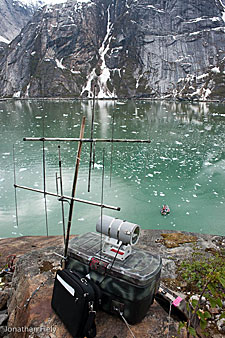Harbor Seal Research
Measurement of Heart Rate
Harbor seals commonly haul out on floating icebergs calved from tidewater glaciers; during the summer months, these glacial waters are also frequented by tour boats. Peak boat tourism occurs during the summer and coincides with harbor seal pupping, nursing and molting. Harbor seals are leanest during the summer, utilizing their fat reserves during these energy-intensive life-history periods. In popular tour boat destinations, seals may be repeatedly disturbed by vessel traffic; the cumulative effect of these additional energetic costs could decrease individual animal fitness and, ultimately, survival.

Most studies of anthropomorphic disturbance of phocids (i.e., seals) measure behavior and define disturbance as entry into the water from a haul-out platform. However, behavior alone may not be a reliable indicator of the timing, magnitude, or associated physiological cost of disturbances. The objective of this study is to measure the physiological response of harbor seals to vessel disturbance, estimate the associated increase in energetic costs, and describe the behaviors associated with the first discernable physiological response. In Endicott Arm, Alaska, over a 3-year period we fitted harbor seals with external data-loggers that recorded dive depth and heart rate. A field camp and two remote data-collection stations were assembled on shore to record timing of boat traffic, distance between boats and seals, and behaviors with boats in close proximity and when no boats were present.
Preliminary results indicate that a discernible physiological response occurs prior to when seals enter the water as vessels get closer and that vessel traffic may present harbor seals with an additional energetic burden. Additional analyses are underway to more fully understand the extent of the energetic costs of vessel disturbance and whether there is a potential for cumulative effects that could negatively affect harbor seals as individuals and as a population.
Objectives:
- Define the distance and behavior at the time that the first physiological stress response occurs when a harbor seal is approached by a boat.
- Examine the energetic costs associated with disturbances.
- Examine the energetics associated with diving and foraging in a glacial inlet.
- Produce a model that will incorporate estimates of energetic costs of living and foraging in a glacial environment (from ADF&G data and published literature), energetic costs of growth and reproduction (from published literature), and energetic costs of vessel disturbance (from ADF&G data). This model will be used to determine at what point cumulative effects of vessel disturbance could negatively affect reproductive success or survival.
Results of this research will be provided to the National Marine Fisheries Service (NMFS) – the agency with management authority for harbor seals under the Marine Mammal Protection Act. Results of our study and others will enable NMFS to determine whether revisions are needed to the current guidelines and regulations for viewing harbor seals that will allow seals and tour boats to share glacial inlets without negative consequences for seals.
This study has been conducted under MMPA NMFS permit # 358-1787. Special thanks to the USFS for their help and cooperation allowing us to set up the remote data-collection stations and the field camp on National Forest lands. For additional information concerning this project, contact Shawna Karpovich at (907) 459-7239; email shawna.karpovich@alaska.gov.
